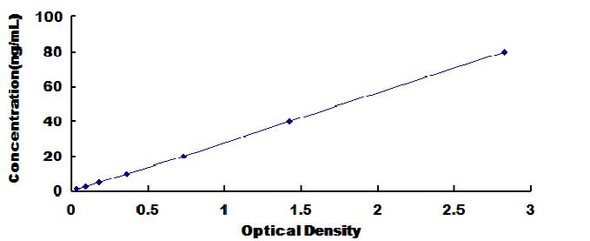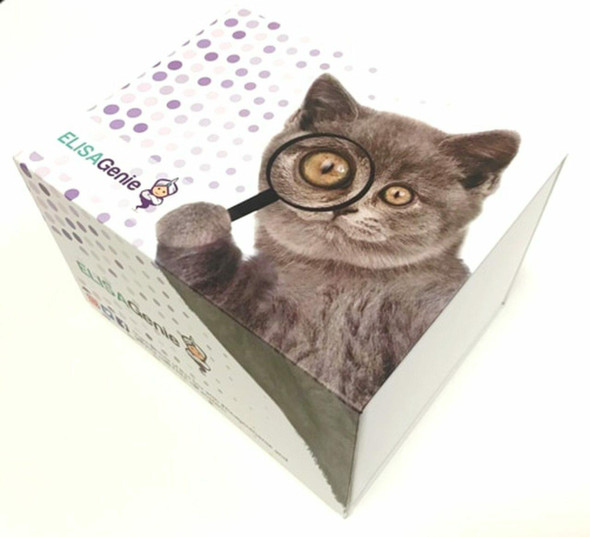Human Developmental Biology ELISA Kits
Human SFRP2 (Secreted Frizzled Related Protein 2) CLIA Kit (HUES00758)
- SKU:
- HUES00758
- Product Type:
- ELISA Kit
- ELISA Type:
- CLIA Kit
- Size:
- 96 Assays
- Sensitivity:
- 0.19ng/mL
- Range:
- 0.31-20ng/mL
- ELISA Type:
- Sandwich
- Reactivity:
- Human
- Sample Type:
- Serum, plasma and other biological fluids
- Research Area:
- Developmental Biology
Description
| Assay type: | Sandwich |
| Format: | 96T |
| Assay time: | 4.5h |
| Reactivity: | Human |
| Detection method: | Chemiluminescence |
| Detection range: | 0.31-20 ng/mL |
| Sensitivity: | 0.19 ng/mL |
| Sample volume: | 100µL |
| Sample type: | Serum, plasma and other biological fluids |
| Repeatability: | CV < 15% |
| Specificity: | This kit recognizes Human SFRP2 in samples. No significant cross-reactivity or interference between Human SFRP2 and analogues was observed. |
This kit uses Sandwich-CLIA as the method. The micro CLIA plate provided in this kit has been pre-coated with an antibody specific to Human SFRP2. Standards or samples are added to the appropriate micro CLIA plate wells and combined with the specific antibody. Then a biotinylated detection antibody specific for Human SFRP2 and Avidin-Horseradish Peroxidase (HRP) conjugate are added to each micro plate well successively and incubated. Free components are washed away. The substrate solution is added to each well. Only those wells that contain Human SFRP2, biotinylated detection antibody and Avidin-HRP conjugate will appear fluorescence. The Relative light unit (RLU) value is measured spectrophotometrically by the Chemiluminescence immunoassay analyzer. The RLU value is positively associated with the concentration of Human SFRP2. The concentration of Human SFRP2 in the samples can be calculated by comparing the RLU of the samples to the standard curve.
| UniProt Protein Function: | SFRP2: Soluble frizzled-related proteins (sFRPS) function as modulators of Wnt signaling through direct interaction with Wnts. They have a role in regulating cell growth and differentiation in specific cell types. SFRP2 may be important for eye retinal development and for myogenesis. Belongs to the secreted frizzled-related protein (sFRP) family. |
| UniProt Protein Details: | Protein type:Secreted, signal peptide; Secreted Chromosomal Location of Human Ortholog: 4q31. 3 Cellular Component: extracellular matrix; extracellular space; integral to membrane Molecular Function:G-protein coupled receptor activity; integrin binding; Wnt-protein binding; Wnt receptor activity; fibronectin binding; receptor agonist activity Biological Process: convergent extension involved in axis elongation; collagen fibril organization; negative regulation of Wnt receptor signaling pathway; positive regulation of apoptosis; negative regulation of caspase activity; negative regulation of BMP signaling pathway; negative regulation of cell proliferation; cell-cell signaling; negative regulation of mesodermal cell fate specification; positive regulation of cell proliferation; negative regulation of cell migration; response to nutrient; negative regulation of epithelial cell proliferation; response to drug; negative regulation of JNK activity; negative regulation of peptidyl-tyrosine phosphorylation; male gonad development; positive regulation of cell adhesion mediated by integrin; digestive tract morphogenesis; chondrocyte development; positive regulation of peptidyl-serine phosphorylation; positive regulation of cell growth; patterning of blood vessels; positive regulation of osteoblast differentiation; positive regulation of angiogenesis; neural tube closure; cellular response to extracellular stimulus; positive regulation of fat cell differentiation; positive regulation of transcription from RNA polymerase II promoter; embryonic digit morphogenesis; negative regulation of cell growth; negative regulation of transcription, DNA-dependent |
| NCBI Summary: | This gene encodes a member of the SFRP family that contains a cysteine-rich domain homologous to the putative Wnt-binding site of Frizzled proteins. SFRPs act as soluble modulators of Wnt signaling. Methylation of this gene is a potential marker for the presence of colorectal cancer. [provided by RefSeq, Jul 2008] |
| UniProt Code: | Q96HF1 |
| NCBI GenInfo Identifier: | 61216828 |
| NCBI Gene ID: | 6423 |
| NCBI Accession: | Q96HF1. 2 |
| UniProt Secondary Accession: | Q96HF1,O14778, Q9HAP5, B3KQR2, |
| UniProt Related Accession: | Q96HF1 |
| Molecular Weight: | 295 |
| NCBI Full Name: | Secreted frizzled-related protein 2 |
| NCBI Synonym Full Names: | secreted frizzled-related protein 2 |
| NCBI Official Symbol: | SFRP2 |
| NCBI Official Synonym Symbols: | FRP-2; SARP1; SDF-5 |
| NCBI Protein Information: | secreted frizzled-related protein 2; SARP-1; sFRP-2; secreted apoptosis related protein 1; secreted apoptosis-related protein 1 |
| UniProt Protein Name: | Secreted frizzled-related protein 2 |
| UniProt Synonym Protein Names: | Secreted apoptosis-related protein 1; SARP-1 |
| Protein Family: | Secreted frizzled-related protein |
| UniProt Gene Name: | SFRP2 |
| UniProt Entry Name: | SFRP2_HUMAN |
As the RLU values of the standard curve may vary according to the conditions of the actual assay performance (e. g. operator, pipetting technique, washing technique or temperature effects), the operator should establish a standard curve for each test. Typical standard curve and data is provided below for reference only.
| Concentration (ng/mL) | RLU | Average | Corrected |
| 20 | 32889 35075 | 33982 | 33950 |
| 10 | 12199 12741 | 12470 | 12438 |
| 5 | 5490 5010 | 5250 | 5218 |
| 2.5 | 2348 2700 | 2524 | 2492 |
| 1.25 | 1438 1328 | 1383 | 1351 |
| 0.63 | 917 817 | 867 | 835 |
| 0.31 | 613 633 | 623 | 591 |
| 0 | 31 33 | 32 | -- |
Precision
Intra-assay Precision (Precision within an assay): 3 samples with low, mid range and high level Human SFRP2 were tested 20 times on one plate, respectively.
Inter-assay Precision (Precision between assays): 3 samples with low, mid range and high level Human SFRP2 were tested on 3 different plates, 20 replicates in each plate.
| Intra-assay Precision | Inter-assay Precision | |||||
| Sample | 1 | 2 | 3 | 1 | 2 | 3 |
| n | 20 | 20 | 20 | 20 | 20 | 20 |
| Mean (ng/mL) | 1.00 | 1.92 | 6.77 | 0.99 | 1.81 | 6.55 |
| Standard deviation | 0.11 | 0.17 | 0.73 | 0.09 | 0.13 | 0.63 |
| C V (%) | 11.00 | 8.85 | 10.78 | 9.09 | 7.18 | 9.62 |
Recovery
The recovery of Human SFRP2 spiked at three different levels in samples throughout the range of the assay was evaluated in various matrices.
| Sample Type | Range (%) | Average Recovery (%) |
| Serum (n=5) | 83-98 | 90 |
| EDTA plasma (n=5) | 100-117 | 108 |
| Cell culture media (n=5) | 86-99 | 91 |
Linearity
Samples were spiked with high concentrations of Human SFRP2 and diluted with Reference Standard & Sample Diluent to produce samples with values within the range of the assay.
| Serum (n=5) | EDTA plasma (n=5) | Cell culture media (n=5) | ||
| 1:2 | Range (%) | 91-105 | 90-103 | 95-109 |
| Average (%) | 97 | 97 | 102 | |
| 1:4 | Range (%) | 97-110 | 86-101 | 96-109 |
| Average (%) | 104 | 92 | 101 | |
| 1:8 | Range (%) | 89-101 | 101-112 | 88-103 |
| Average (%) | 95 | 106 | 95 | |
| 1:16 | Range (%) | 94-105 | 101-116 | 92-105 |
| Average (%) | 99 | 108 | 98 |
An unopened kit can be stored at 4°C for 1 month. If the kit is not used within 1 month, store the items separately according to the following conditions once the kit is received.
| Item | Specifications | Storage |
| Micro CLIA Plate(Dismountable) | 8 wells ×12 strips | -20°C, 6 months |
| Reference Standard | 2 vials | |
| Concentrated Biotinylated Detection Ab (100×) | 1 vial, 120 µL | |
| Concentrated HRP Conjugate (100×) | 1 vial, 120 µL | -20°C(shading light), 6 months |
| Reference Standard & Sample Diluent | 1 vial, 20 mL | 4°C, 6 months |
| Biotinylated Detection Ab Diluent | 1 vial, 14 mL | |
| HRP Conjugate Diluent | 1 vial, 14 mL | |
| Concentrated Wash Buffer (25×) | 1 vial, 30 mL | |
| Substrate Reagent A | 1 vial, 5 mL | 4°C (shading light) |
| Substrate Reagent B | 1 vial, 5 mL | 4°C (shading light) |
| Plate Sealer | 5 pieces | |
| Product Description | 1 copy | |
| Certificate of Analysis | 1 copy |
- Set standard, test sample and control (zero) wells on the pre-coated plate and record theirpositions. It is recommended to measure each standard and sample in duplicate. Note: addall solutions to the bottom of the plate wells while avoiding contact with the well walls. Ensuresolutions do not foam when adding to the wells.
- Aliquot 100µl of standard solutions into the standard wells.
- Add 100µl of Sample / Standard dilution buffer into the control (zero) well.
- Add 100µl of properly diluted sample (serum, plasma, tissue homogenates and otherbiological fluids. ) into test sample wells.
- Cover the plate with the sealer provided in the kit and incubate for 90 min at 37°C.
- Aspirate the liquid from each well, do not wash. Immediately add 100µL of BiotinylatedDetection Ab working solution to each well. Cover the plate with a plate seal and gently mix. Incubate for 1 hour at 37°C.
- Aspirate or decant the solution from the plate and add 350µL of wash buffer to each welland incubate for 1-2 minutes at room temperature. Aspirate the solution from each well andclap the plate on absorbent filter paper to dry. Repeat this process 3 times. Note: a microplatewasher can be used in this step and other wash steps.
- Add 100µL of HRP Conjugate working solution to each well. Cover with a plate seal andincubate for 30 min at 37°C.
- Aspirate or decant the solution from each well. Repeat the wash process for five times asconducted in step 7.
- Add 100µL of Substrate mixture solution to each well. Cover with a new plate seal andincubate for no more than 5 min at 37°C. Protect the plate from light.
- Determine the RLU value of each well immediately.






